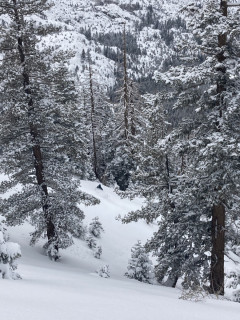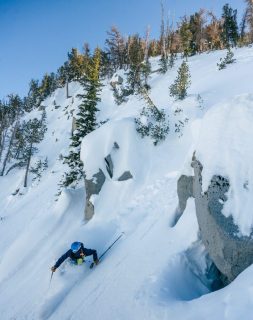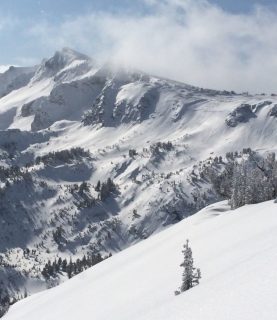How To Read The Avalanche Forecast
This page will help explain the avalanche forecast product issued by the Eastern Sierra Avalanche Center (ESAC). Specific application of the information contained within the forecast while traveling in avalanche terrain is up to the user and is an advanced skill. The daily avalanche forecast is only a starting place for terrain choice and decision making in avalanche terrain. Many other factors contribute to safe travel in the mountains including human factors such as biases, heuristics and communication amongst team members. Ongoing field observations are an invaluable tool for confirming changing snowpack stability conditions for the specific time and place where you find yourself.
The avalanche forecast is designed to simply communicate avalanche hazard to backcountry recreationists, industry professionals, and emergency responders.
Avalanche forecasters analyze professional and public snow observations from across the area, along with daily weather forecasts to create the avalanche advisory. Please note, the forecast is not a substitute for professional avalanche education and will be easier to understand and apply after taking an avalanche awareness or Level 1 class.
Our forecast area is extensive and conditions do change spatially and temporally. Local assessments of conditions can help to confirm the avalanche hazard in the area in which you are traveling.
The ESAC Forecast Area
ESAC produces avalanche forecasts and snowpack summaries for an area stretching from Bishop Creek (south) to Virginia Lakes (north) in the Eastern Sierra Nevada mountains of California. Our forecast area includes the mountainous terrain from HWY 395 west to the crest of the Sierra Nevada. This forecast area is large and complex with significant topographical relief, deep canyons, and a variety of weather patterns, which all affect the distribution and characteristics of the snow. Conditions often vary wildly between neighboring canyons, never mind the distance between Bishop Creek and Lee Vining Creek. Specific local observations of conditions will support the use of the ESAC forecast for decision-making in avalanche terrain. Avalanche forecasts are not necessarily applicable to extreme terrain in the high alpine where it is difficult or dangerous to gather accurate data, and spatial variability of snowpack stability changes rapidly.

The Forecast Schedule
The avalanche forecast is issued daily by 7 AM for the bulk of the season and snowpack summaries are issued 3-4 times a week during the shoulder seasons. Check the timestamp of the forecast to ensure that it is for the period for which you will be traveling in the mountains.
The Bottom Line
The Bottom Line is a brief discussion of the key points of the avalanche advisory and is accompanied by the mountain graphic which provides a snapshot of the forecast avalanche danger for the forecast period at 3 different elevation bands. The danger rating expressed in the bottom line discussion is the highest forecast danger rating across the 3 different elevation bands.
The Outlook which accompanies the danger rating/mountain graphic is different than today’s danger rating. The Outlook has a higher degree of uncertainty associated with it, but it can still communicate expected trends over time.

The Mountain Graphic
The Mountain Graphic accompanies the Bottom Line as an introduction to the full avalanche forecast. The Mountain Graphic shows the forecast avalanche danger level for 3 general elevation bands throughout the forecast area.
Above Treeline (ATL) is the highest of the three elevation bands used in the ESAC advisories. It includes alpine areas where the most snow falls and the winds are the strongest. It is not an exact elevation, but a characteristic of the terrain, beginning as the treeline transitions into open slopes extending to ridges and the tops of the highest peaks.
Near Treeline (NTL) is the middle of the three elevation bands used in the ESAC advisories. It is a transition zone between dense forests and treeless alpine areas. It is the narrowest of the three elevation bands, extending only a few hundred feet above and below the treeline. It varies locally and is not a constant elevation or width. Conditions are highly variable in both near and above treeline terrain.
Below Treeline (BTL) is the lowest of three elevation bands used in the ESAC advisories. It extends from valley floors or snowline to Near Treeline. Open areas and sparse trees are possible. Avalanche terrain is sometimes less obvious BTL as the presence of thicker trees can provide a false sense of safety.
The Avalanche Danger Scale
The North American Public Avalanche Danger Scale is used to communicate the hazard posed by avalanches for a specific time period. The danger rating is a combination of the expected likelihood, size, and distribution of avalanches. Danger Ratings are assigned to the forecast when ESAC is issuing daily avalanche forecasts. Snowpack summaries issued during the shoulder seasons do not include a danger rating, but more generally summarize snowpack conditions.
The danger scale is not linear, meaning that each increased step along the scale is exponentially higher than the previous.
Did you know that most avalanche accidents occur during periods of Moderate and Considerable danger?
The only way to eliminate your exposure to avalanches is to avoid avalanche terrain.
Watch this short video from the National Avalanche Center for more information about the North American Public Avalanche Danger Scale
Avalanche Problems
A set of 4 factors (avalanche character, location, likelihood, destructive size) are combined and used to elaborate on the expected avalanche hazard for the day. These 4 factors are collectively known as the “Avalanche Problem.” Understanding forecast avalanche problems can help with planning backcountry trips and decision-making in the field.
Avalanche Character/Type
There are many different kinds of avalanches and each has its own unique characteristics that influence terrain and travel choices. In North America, we use 9 distinct characters to describe avalanche types. Each of these different characters has a unique icon used in the forecast. For more information on different avalanche types, click HERE.
Location
Avalanche forecasters utilize a “rose” to illustrate the expected distribution of expected avalanches by highlighting the elevation and aspect. The aspect of a slope is the direction (N-E-S-W etc.) the slope faces; and elevation is expressed using 3 different elevation bands (Below Treeline, Near Treeline, Above Treeline) which were described above.
This diagram is a representation of how the pattern of avalanche conditions may have developed. The grey shaded areas show you the general aspect and elevation where you will MOST LIKELY find the specific avalanche type, not all the places where it might exist within the terrain.
Likelihood
Likelihood describes the probability of a single person triggering that type of avalanche in the terrain specified. The likelihood of triggering an avalanche can change from day to day and sometimes from hour to hour. The Likelihood of triggering an avalanche is described using terms such as Unlikely, Likely, and Certain. The term applied reflects the highest likelihood expected on that day.
Size
The destructive size of an avalanche is based on the “D scale” and is described in our advisory using terms such as Small, Large, Very Large, and Historic. These terms reflect the destructive potential of avalanches triggered on that day. Small avalanches (D1) are not large enough to bury a person but are dangerous and potentially deadly if they are encountered in consequential terrain. Large-sized avalanches (D2) are large enough to bury, injure or kill a person. Very Large avalanches (D3), can bury or destroy a car, damage a truck, destroy a small building or break a few trees. Historic avalanches (D4-D5) can bury and destroy trucks or trains and can also destroy fairly large buildings and small areas of forest or in extreme circumstances (D5) can devastate the landscape and have catastrophic destructive potential; these are rare and exceptional events by definition.
Forecast Discussion
The Forecast Discussion is used by forecasters to describe in more detail, recent snowpack or weather trends, non-avalanche related hazards, and stability concerns more generally. This section is often used to expand upon specific avalanche problems, offer detailed travel advice, or describe forecaster confidence. While the most crucial information on stability is contained in the sections above, the advisory discussion often contains more nuanced descriptions and can provide valuable information to users as they plan their day.
Recent Observations
This section of the forecast contains links to and descriptions of recent snowpack and avalanche observations. These field observations are submitted by forecasters, professional mountain guides, ski patrollers, as well as members of the public, and provide point-specific information on recent weather or avalanche activity. Field observations are incredibly valuable to the forecasting staff as they create the advisory and are available for the public to read on our website. Follow this LINK to submit your own observations, or to view a more extensive list of recent observations please visit the observation page by clicking HERE.
Current Weather and Snow Conditions
This section describes pertinent weather forecast information. A weather discussion describes current conditions and patterns that may be developing. This is followed by a Two-Day Mountain Weather Forecast, listed in a simple table format.
Finally, it is important to remember the avalanche advisory is designed to generally describe avalanche conditions over a large area where local variations always occur. Avalanche conditions can change drastically over a short period of time and from one location to another. The Advisory paints a picture of conditions with a broad brush and applies only to backcountry areas located within our forecast area, and outside of established ski area boundaries.


